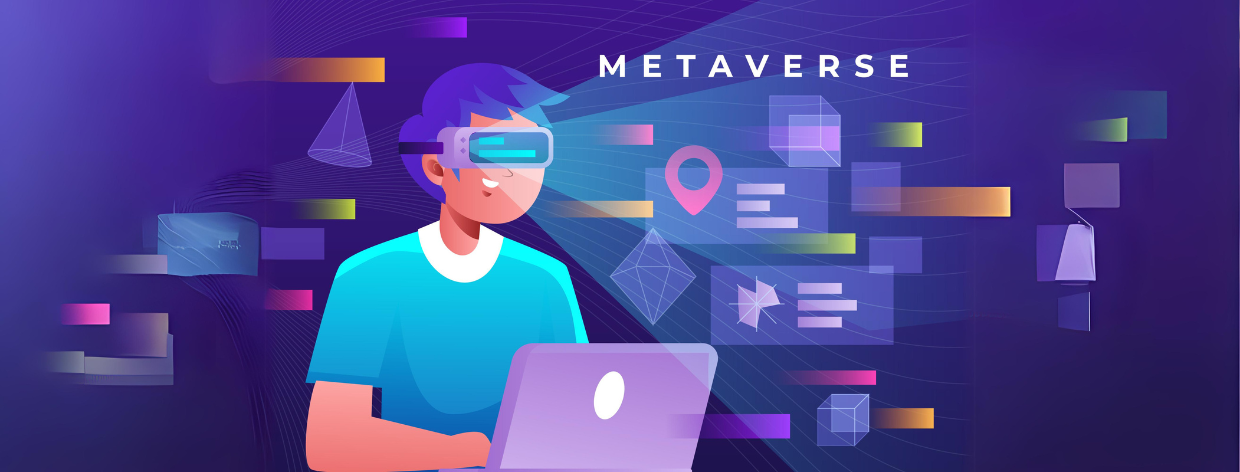
- 26th Feb 2024
- 22:31 pm
Consider a 3D virtual environment that integrates seamlessly with our physical world. That is the underlying concept of the Metaverse—a linked network of virtual locations where people may socialize, have fun, and conduct business. Meanwhile, Web3 represents the internet's future, with a focus on decentralization and allowing consumers to own data.
Python's Role in Web3:
Python is becoming important for connecting the Metaverse and Web3. Its simplicity, flexibility, and many libraries make it great for building decentralized apps (dApps) that work with different Web3 parts.
How People Interact:
Understanding how people use the Metaverse and Web3 helps make better experiences.
- DAOs (Decentralized Autonomous Organizations): These are groups run by the community. They use Python tools to vote and manage shared things.
- NFTs (Non-Fungible Tokens): With Python, you can make, trade, and handle special digital things like art or game items.
- Virtual Worlds: Python lets developers create cool virtual worlds with game tools and 3D graphics.
Explore the Metaverse and Web3 revolution with Python! Learn how to build groundbreaking applications and bridge the gap between worlds with our experts and comprehensive Python Assignment Help and Python Homework Help.
Understanding Decentralized Autonomous Organizations (DAOs)
Consider a non-centralized organization in which members make choices jointly. This is the essence of the Decentralized Autonomous Organization (DAO). DAOs run on blockchain, a distributed ledger that records transactions publicly and immutably. This promotes transparency, trust, and collective ownership inside the organization.
Overview of the DAO governance structures:
DAOs often use smart contracts, which are self-running code on the blockchain, to set their rules and manage activities. Members join in decision-making by suggesting ideas and voting with special tokens called governance tokens, which show their right to vote. Some DAOs let people vote directly on the blockchain, while others use different platforms for voting to be more flexible.
Examining Python libraries and frameworks for working with DAOs:
Python provides a variety of tools and frameworks for interfacing with DAOs.
- Web3.py allows you to connect to the Ethereum blockchain and interact with DAO smart contracts.
- DAOstack: Offers a set of tools for creating and operating DAOs, including voting and governance features.
- Alchemy provides developer APIs for accessing and querying blockchain data, including details on DAOs and their operations.
These tools enable developers to create applications that interact with DAOs, including voting, proposal creation, and other DAO-related features.
Nonfungible Tokens (NFTs) and Python
What is an NFT and how do they work?
Think of an NFT as a special digital certificate proving ownership of something, like art or a virtual item. Unlike regular tokens such as Bitcoin, each NFT is unique and can't be divided. It shows ownership of a specific digital thing kept on the blockchain.
Uses for NFTs in the Metaverse and Beyond:
- In the Metaverse: NFTs can show who owns virtual stuff like land, avatars, and game items, helping to build a digital economy.
- For Art and Collectibles: NFTs allow artists to create and sell one-of-a-kind digital art while ensuring authenticity and proving ownership.
- Events and experiences: NFTs can be used as tickets for concerts, conferences, or exclusive experiences, offering unique benefits to holders.
Python Tools and Libraries for NFT Creation, Management, and Trading:
Python offers libraries for dealing with the NFT ecosystem.
- OpenSea.py: Provides an interface to the OpenSea NFT marketplace, allowing interaction with listings and data.
- Etherscan.io: Offers APIs for accessing and analyzing blockchain data, such as NFT transactions and ownership details.
- Web3.py, as previously indicated, may be used to interface with NFT smart contracts, making it easier to create, transfer, and administer NFTs.
Python developers can use these tools to create, manage, and trade NFTs, helping to shape the emerging environment of digital ownership and the metaverse.
Exploring Virtual Worlds with Python Integration
Consider creating immersive 3D settings in which people may mingle, play games, and interact with digital goods. These are virtual worlds, which play an important role in the Metaverse. They offer a platform for new forms of entertainment, employment, and social engagement.
Relationships between Python and virtual world platforms:
Python may be linked with popular game engines such as Unity and Unreal Engine with scripting languages such as Python for Unity (C#) and PySide for Unreal Engine (C++). This allows for scripting logic, game mechanisms, and user interactions into virtual worlds.
- 3D libraries: Python includes libraries for producing and editing 3D visuals, such as PyOpenGL and Panda3D, which allow developers to create virtual worlds and objects across platforms.
- Server-side development: Python is suitable for server-side development on virtual world platforms. This provides for the management of user accounts, real-time communication, and the maintenance of the virtual world's internal logic.
Python use cases for creating and scripting virtual environments:
- Creating interactive elements involves scripting virtual objects, avatars, and user interfaces in Python within game engines or specific libraries.
- Creating server-side logic entails building the backend infrastructure for virtual worlds, handling user interactions, and ensuring data durability.
- Automating repetitive chores: Python scripts are used to automate repetitive processes in virtual world development, such as environment creation and functional testing.
- Developers may help create compelling and interactive virtual experiences in the Metaverse by exploiting Python's adaptability and powerful libraries.
Integrating Python and Web3 Platforms
Web3 is the internet's next incarnation, based on decentralization and user ownership. Web3 platforms are apps and services that run within this ecosystem, utilizing blockchain technology and protocols such as Ethereum, Solana, and Polygon.
Python packages and frameworks for working with Web3 APIs:
- Web3.py: This popular library enables interaction with the Ethereum blockchain by connecting to nodes, calling smart contracts, and dealing with numerous Web3 functions.
- Alchemy provides developer APIs for accessing and querying blockchain data across several chains, giving useful insights into Web3 operations.
- Etherscan.io offers Python modules for interacting with the Ethereum blockchain explorer, allowing for data retrieval and analysis of transactions, smart contracts, and NFT ownership.
Sample Python scripts for Web3 integration with DAOs, NFTs, and virtual worlds:
- DAO voting script: A script that uses Web3.py to connect to a DAO's smart contract, allowing users to vote on ideas and participate in governance.
- NFT minting script: A Web3.py script that interacts with an NFT smart contract, allowing you to create and mint unique NFTs in the Metaverse.
- Virtual world asset management script: A server-side Python script that uses Web3.py to track user ownership of virtual assets within a virtual world in a secure and transparent manner.
These examples demonstrate the various options for integrating Python with Web3 platforms, allowing developers to create creative applications and contribute to the growing landscape of the decentralized web.
Building Applications using Python and Web3
Python Applications in the Metaverse
Python, with its readability and rich libraries, is ideal for Metaverse development. It excels at backend apps, APIs, and data analysis, and is responsible for the infrastructure that powers Metaverse experiences.
Integrating DAOs, NFTs, and Virtual Worlds.
- DAOs (Decentralized Autonomous Organizations): Python helps apps work with DAOs in the Metaverse for managing governance, voting, and finances.
- Non-Fungible Tokens (NFTs): Python makes it easy to create programs for making, trading, and managing NFTs, letting people join the digital asset world.
- Virtual Worlds: Python helps set up and use virtual worlds, including avatars, objects, and moving around in space.
Examples of Python-based Web3 applications
- Metaverse marketplaces: Python can operate platforms where you can buy, sell, and handle virtual things in the Metaverse.
- Decentralized finance (DeFi) apps: Python can make tools for using and controlling DeFi services in the Metaverse, making financial transactions easier and faster.
- Data analysis and visualization tools: Python can analyze user activity, economic patterns, and asset ownership in the Metaverse to provide useful insights.
Real-world Applications and Case Studies
Python projects that integrate with web3 platforms.
- Decentraland: Python tools such as 'pyDCL' allow you to create interactive experiences within the Decentraland virtual environment.
- The Sandbox: Python SDKs like as 'The Sandbox' enable integration with a game engine to create NFT-based games and experiences.
- MetaMask: Python tools like as 'web3.py' allow for interaction with MetaMask wallets, which facilitates user authentication and transactions within Metaverse apps.
Success Stories for Web3 Integration
- Axie Infinity: This game, where you can earn money by playing, uses NFTs and DAOs, and some parts are made with Python. It helps create a lively digital economy in the Metaverse.
- Decentraland: This virtual world lets you own land, make experiences, and connect with others in a decentralized way, using parts built with Python.
Challenges and Lessons Learned.
- Security: Ensuring secure interaction with Web3 platforms and smart contracts is critical.
- Scalability: Handling enormous user bases and complicated interactions in the Metaverse necessitates efficient Python solutions.
- Evolving landscape: Staying current with the continually changing Web3 ecosystem is critical for effective application development.
Best Practices for Python in the Metaverse
Security Considerations.
- Use safe authentication techniques to enable user engagement with Web3 platforms.
- Thoroughly test and audit smart contracts for vulnerabilities prior to implementation.
- Use libraries and tools with a solid security track record.
Optimization Techniques
- Use caching technologies for frequently requested data to boost application performance.
- Use asynchronous programming techniques to manage numerous requests efficiently.
- Profile and optimize code to find and fix performance bottlenecks.
Collaboration and Community Involvement
- Contribute to open-source projects and connect with the Web3 development community.
- Share expertise and best practices via code repositories, tutorials, and forums.
- Work with other developers to create new and influential Metaverse apps.
Understanding these principles and best practices enables developers to use Python and Web3 to create the next generation of immersive and interactive Metaverse experiences.
Future Trends in Python-Web3 Integration
Emerging Technologies and Protocols
- The Web3 ecosystem is continually changing, with new technologies such as Layer 2 scaling solutions, interoperable blockchains, and zero-knowledge proofs (ZKPs) emerging. Python can help integrate these technologies to create more efficient, scalable, and privacy-preserving Metaverse experiences.
Opportunities for Innovation and Experimentation.
- Python provides limitless opportunities for unique Metaverse projects. Developers may experiment with:
- Develop AI-powered virtual assistants and bots for the Metaverse. - Design immersive learning and educational experiences in virtual spaces.
- Creating tools to manage decentralized identities and data ownership.
The Changing Role of Python
- Python's flexibility and active community will most certainly see it play a larger role in shaping the Metaverse's future. It can drive the development of novel interaction paradigms, decentralized governance models, and creative economic systems in the virtual world.
Conclusion
- Recap: This part looked at how Python and Web3 may work together, focusing on the possibility of DAOs, NFTs, and virtual worlds, and how to build them with Python.
- Transformative Potential: Python's ability to manage complicated data, integrate with blockchain protocols, and create user-friendly applications places it as a game changer in the Web3 era.
- Encouragement: We urge further investigation of Python's capabilities in the Metaverse. Contributing to open-source libraries, creating creative projects, and working with the community will all play an important role in determining the future of this dynamic terrain.









